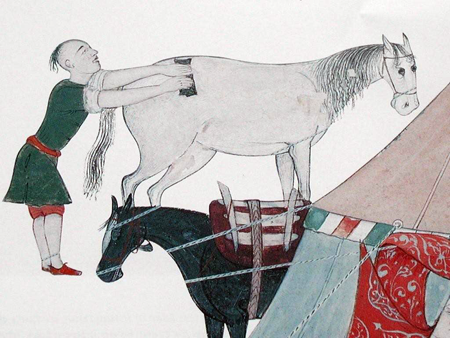COMPLEMENTARITIES OF OSTEOPATHYLike any sensitive approach, osteopathy is, in principle, open to any therapeutic proposal , friendly to the horse in care .
The text ofPhil Rogers expresses exactly this : "Holistic medicine is the best medicine for humans or animals. It embraces the best of conventional medicine, plus the best of "complementary medicine". Where necessary, it includes surgery. It attains optimal clinical results with minimal side effects to the patient and at less cost than high-tech conventional medicine. Holistic medicine examines all the interactions between the external environment and the body-mind-spirit of the patient. It does not view the Syndrome (the Lesion-Symptom Complex) as the disease per se. The Syndrome is only the clinical manifestation of the disease, i.e. the Branch, or end-result, of the body’s defensive reaction, its attempt to try to correct the Energetic Imbalance, which is the Root cause of the disease. In Chinese Medicine, Holistic medicine aims to diagnose the predisposing factors (usually energetic and/or genetic) and the precipitating factors (usually external factors, but sometimes internal-emotional factors) that trigger the Syndrome in the weak physical structures, organs or parts of the body or in the psyche / spirit of the patient. It places less importance on the Syndrome (Branch) and the weak physical structures than on the Root causes. Treating the Branch is like taking an analgesic for a headache, or an antibiotic for a bacterial infection. It may be necessary for rapid symptomatic relief, but it does NOT address the Root cause of the headache, or of the suppressed immune status that allowed the bacteria to overcome the body’s natural defences. Where possible, holistic medicine Treats the Root, i.e uses whatever methods are needed to remove, neutralise or alleviate the root causes of disease. Its modalities include acupuncture, herbal (especially oriental) medicine, homeopathy, immunostimulation therapy, osteopathy / chiropractic, nutritional supplements, dietary adjustment, advice on lifestyle, physical / mental exercises, stress control / hypnosis / relaxation therapy, etc. When indicated, it also uses conventional physiotherapy, medicine, surgery, nutrition, counselling, etc. If Root Treatment does not give the desired result, and in all syndromes that pose a serious threat to life, it Treats the Branch, i.e. to tackle the symptoms and or lesions directly. In many cases, for example in severe pain, it combines Branch and Root treatment, including helping the client to attain a more balanced mental-spiritual state." “Phil ROGERS” http://homepage.eircom.net/ progers/roghome.htm The essence of osteopathy is to find the primary lesion, the root of the problem, and to deal with it by the most effective means: it can be a digestive disorder resulting from a feeding problem, a stressful environment, a congenital malformation, bad harnessing, a shoeing problem, poor track work ... the causes are multiple and sometimes old and forgotten. We should remain open minded to any possibility. It is simplistic to summarize a locomotor disorder to, for example, a painful fetlock. Why this joint is painful, what is the root cause, how to prevent recurrence and ensure that the horse copes well with his arthritis? There may be a different answer for each patient! The difficulty is not to have information but to give them meaning and to prioritize Acupuncture may be a first approach on a horse hypertensive or hyper allergic, allowing at the same time an osteopathic approach otherwise impossible. This can sometimes be the only effective therapy in depletion capacity for self-body cure. The discovery of major dysfunctions should guide the osteopath to tests: radiography, ultrasound, endoscopy, scintigraphy, any modern means of science to define the problem. It is very difficult to accurately identify what the responsibility of osteopathic manipulation is or not, the experience is of great help, but, I think, especially the perpetual challenge of his choice and his diagnosis. . |
